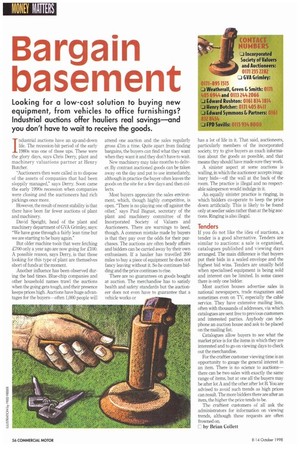Bargain basement
Page 58

If you've noticed an error in this article please click here to report it so we can fix it.
Looking for a low-cost solution to buying new equipment, from vehicles to office furnishings? Industrial auctions offer hauliers real savings—and you don't have to wait to receive the goods.
Industrial auctions have an up-and-down life. The recession-hit period of the early 1980s was one of those ups. These were the glory days, says Chris Derry, plant and machinery valuations partner at Henry Butcher.
"Auctioneers then were called in to dispose of the assets of companies that had been sloppily managed," says Derry. Soon came the early 1990s recession when companies were closing and the auctioneers had rich pickings once more.
However, the result of recent stability is that there have been far fewer auctions of plant and machinery.
David Speight, head of the plant and machinery department of GVA Grimley, says: "We have gone through a fairly lean time but we are starting to be busy again."
But older machine tools that were fetching 000 only a year ago are now going for £100. A possible reason, says Derry, is that those looking for this type of plant are themselves short of funds at the moment.
Another influence has been observed during the bad times. Blue-chip companies and other household names trawl the auctions when the going gets tough, and their presence keeps prices high. Auctions have huge advantages for the buyers—often 1,000 people will
attend one auction and the sales regularly gross Lim a time. Quite apart from finding bargains, the buyers can find what they want when they want it and they don't have to wait.
New machinery may take months to deliver. By contrast auctioned goods can be taken away on the day and put to use immediately, although in practice the buyer often leaves the goods on the site for a few days and then collects.
Most buyers appreciate the sales environment, which, though highly competitive, is open. "There is no playing one off against the other," says Paul Bagust, secretary of the plant and machinery committee of the Incorporated Society of Valuers and Auctioneers. There are warnings to heed, though. A common mistake made by buyers is that they pay over the odds for their purchases. The auctions are often heady affairs and bidders can be carried away by their own enthusiasm. If a haulier has travelled 200 miles to buy a piece of equipment he does not fancy leaving without it. So he continues bidding and the price continues to rise.
There are no guarantees on goods bought at auction. The merchandise has to satisfy health and safety standards but the auctioneer does not even have to guarantee that a vehicle works or has a lot of life in it. That said, auctioneers, particularly members of the incorporated society, try to give buyers as much information about the goods as possible, and that means they should have made sure they work.
A sinister aspect at some auctions is walling, in which the auctioneer accepts imaginary bids—off the wall at the back of the room. The practice is illegal and no respectable salesperson would indulge in it.
An equally sinister practice is ringing, in which bidders co-operate to keep the price down artificially. This is likely to be found only at seedier sales rather than at the big auctions. Ringing is also illegal.
Tenders
If you do not like the idea of auctions, a tender is a good alternative. Tenders are similar to auctions: a sale is organised, catalogues published and viewing days arranged. The main difference is that buyers put their bids in a sealed envelope and the highest bid wins. Tenders are usually held when specialised equipment is being sold and interest can be limited. In some cases there is only one bidder.
Most auction houses advertise sales in national newspapers, trade magazines and sometimes even on TV, especially the cable service. They have extensive mailing lists, often with thousands of addresses, via which catalogues are sent free to previous customers and interested parties. Anybody can telephone an auction house and ask to be placed on the mailing list.
Catalogues allow buyers to see what the market price is for the items in which they are interested and to go on viewing days to check out the merchandise.
For the craftier customer viewing time is an opportunity to gauge the general interest in an item. There is no science to auctions— there can be two sales with exactly the same range of items, but at one all the buyers may be after lot A and the other after lot B. You are advised to avoid such trends as high prices can result The more bidders there are after an item, the higher the price tends to be.
The craftiest customers of all ask the administrators for information on viewing trends, although these requests are often frowned on.
1by Brian Collett


























































































































